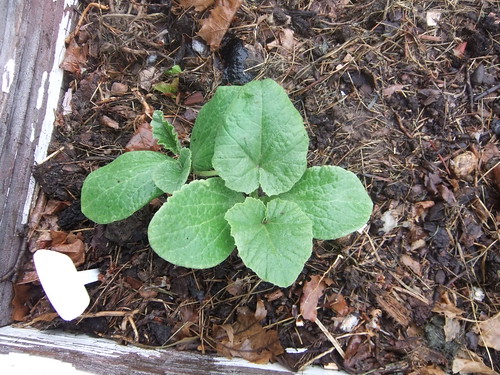Post by oxbowfarm on Aug 1, 2011 1:49:54 GMT -5
hello
My name is Tim, my wife and I are market gardeners in Erin, NY.
I am really impressed at the work you folks are doing here on the forum, it is very inspirational. I hope I can make a contribution at some point.
I am very interested in home breeding projects and adaptive varieties.
My two main foci are to provide Oxbow Farm with attractive and unusual vegetables to differentiate us from the competition at market and to create strains and varieties of calorie staples that work well here for greater food independence in light of peak oil concerns that I have.
I am a big admirer of Eliot Coleman and have been actively implementing his winter harvest/ mobile high tunnel growing system on our farm. The high tunnels have been huge income producers for us so far and I am trying as hard as I can to build more of them as time and money allow. I also view them as a viable post -oil technology, at least in the medium term. I have been building my own 15 by 48 foot tunnels as the only commercially available units are extremely expensive.
I have dabbled with breeding work. I have a winter squash Maxima grex involving Lakota squash, Rio Lucio Pumpkin, and Navajo hubbard that is in the F3 stage. I was astounded with the amazing thickness and size of the southwestern maxima seeds and am trying to adapt them to local conditions, I have some concerns that the thickness is mostly seed coat vs larger edible seed though. They have done very well for me but are for the most part to large to sell at market. More of a survival variety. I am interested in incorporating Sweet Meat into the mix and selecting for the thicker flesh and reportedly fantastic sweet flavor along with the thick seed trait, even if the thick seeds aren't a more edible trait, they are incredibly beautiful IMO.
I have a mass cross of dent corns as well but I may be abandoning it in favor of flint or flour after reading the Resilient Gardener. I requested three varieties of white flour corn (NSL 202125,NSL 202124, Ames 2355) that are of the general type once grown by the native americans in this area. I have some thought to crossing them with Painted Mountain to obtain the flavored color classes that Carol Deppe speaks of. My dent corn is a very variable mass cross of Bloody Butcher, Oaxacan Green Dent, Early Butler, and Strub's Orange. Lots of things going on with height and maturity and not all of it matures well in my climatic zone. If anyone wants some I have several bushels of unshelled cobs from last season.
I was unable to plant any corn this spring due to wet weather and needing to focus all my open ground on market purposes.
I am also in the very early stages of a beet breeding project. I grew some sugar beets last year and was amaze at the greens. I am hoping to cross the sugar beet to some red and yellow beets to get some color in the roots to make them more attractive sold as beet greens with small roots. The white roots are unattractively beige and I think the color would make them really interesting on the table. The greens were huge beautiful and delicious. I overwintered some of the sugar beets and a few colored types in the hight tunnel and transplanted them to the garden this spring. They've had it rough lately with all the hot dry weather and I am not sure how well they are doing as I've neglected them for the market stuff.
I have some dreams of working on a red glaze collard green. Probably only really red in the fall but still something worth shooting for. I think I've seen that someone (Raymondo??) is already working in that direction. I'd love to collaborate. I have been thinking of crossing Green Glaze with Red Bull Brussels sprout or with a red cabbage.
I also have had an interesting experience with some savoy cabbage I grew this year. Samantha F1 was on clearance so I bought some to try (I am cheap). It doesn't seem to head up (probably why it was discontinued) but the leaves are these huge round savoy things, totally beautiful. I've been picking them and selling them as savoy collards. They are moving pretty well too. So I was thinking of crossing this cabbage with Lacinato kale to get something like a true savoy collard. I thought it would be fun to try in any case. I am realizing that to do these B. oleracea crosses I'd need some friends to give me some space for a few plants to have isolated crossings.
I also have messed around with cornfield beans. I was trying to see if I a few different varieties would cross and produce new types if grown together in the cornfield. I started with Brown Greasy Cutshort, Amish Gnuttle, and Red Sugar Cutshort. I just liked the way the cutshort beans looked. So far I haven't seen any new color types visually after three years growing them together but its got to be just a matter of time as I see bees working the flowers. I didn't get to grow these ones out this year due to no corn to plant them on. I have about a gallon of seed so folks are welcome if anyone is interested.
I am really humbled by the really neat work you guys are doing and am eager to learn.
thanks.
My name is Tim, my wife and I are market gardeners in Erin, NY.
I am really impressed at the work you folks are doing here on the forum, it is very inspirational. I hope I can make a contribution at some point.
I am very interested in home breeding projects and adaptive varieties.
My two main foci are to provide Oxbow Farm with attractive and unusual vegetables to differentiate us from the competition at market and to create strains and varieties of calorie staples that work well here for greater food independence in light of peak oil concerns that I have.
I am a big admirer of Eliot Coleman and have been actively implementing his winter harvest/ mobile high tunnel growing system on our farm. The high tunnels have been huge income producers for us so far and I am trying as hard as I can to build more of them as time and money allow. I also view them as a viable post -oil technology, at least in the medium term. I have been building my own 15 by 48 foot tunnels as the only commercially available units are extremely expensive.
I have dabbled with breeding work. I have a winter squash Maxima grex involving Lakota squash, Rio Lucio Pumpkin, and Navajo hubbard that is in the F3 stage. I was astounded with the amazing thickness and size of the southwestern maxima seeds and am trying to adapt them to local conditions, I have some concerns that the thickness is mostly seed coat vs larger edible seed though. They have done very well for me but are for the most part to large to sell at market. More of a survival variety. I am interested in incorporating Sweet Meat into the mix and selecting for the thicker flesh and reportedly fantastic sweet flavor along with the thick seed trait, even if the thick seeds aren't a more edible trait, they are incredibly beautiful IMO.
I have a mass cross of dent corns as well but I may be abandoning it in favor of flint or flour after reading the Resilient Gardener. I requested three varieties of white flour corn (NSL 202125,NSL 202124, Ames 2355) that are of the general type once grown by the native americans in this area. I have some thought to crossing them with Painted Mountain to obtain the flavored color classes that Carol Deppe speaks of. My dent corn is a very variable mass cross of Bloody Butcher, Oaxacan Green Dent, Early Butler, and Strub's Orange. Lots of things going on with height and maturity and not all of it matures well in my climatic zone. If anyone wants some I have several bushels of unshelled cobs from last season.
I was unable to plant any corn this spring due to wet weather and needing to focus all my open ground on market purposes.
I am also in the very early stages of a beet breeding project. I grew some sugar beets last year and was amaze at the greens. I am hoping to cross the sugar beet to some red and yellow beets to get some color in the roots to make them more attractive sold as beet greens with small roots. The white roots are unattractively beige and I think the color would make them really interesting on the table. The greens were huge beautiful and delicious. I overwintered some of the sugar beets and a few colored types in the hight tunnel and transplanted them to the garden this spring. They've had it rough lately with all the hot dry weather and I am not sure how well they are doing as I've neglected them for the market stuff.
I have some dreams of working on a red glaze collard green. Probably only really red in the fall but still something worth shooting for. I think I've seen that someone (Raymondo??) is already working in that direction. I'd love to collaborate. I have been thinking of crossing Green Glaze with Red Bull Brussels sprout or with a red cabbage.
I also have had an interesting experience with some savoy cabbage I grew this year. Samantha F1 was on clearance so I bought some to try (I am cheap). It doesn't seem to head up (probably why it was discontinued) but the leaves are these huge round savoy things, totally beautiful. I've been picking them and selling them as savoy collards. They are moving pretty well too. So I was thinking of crossing this cabbage with Lacinato kale to get something like a true savoy collard. I thought it would be fun to try in any case. I am realizing that to do these B. oleracea crosses I'd need some friends to give me some space for a few plants to have isolated crossings.
I also have messed around with cornfield beans. I was trying to see if I a few different varieties would cross and produce new types if grown together in the cornfield. I started with Brown Greasy Cutshort, Amish Gnuttle, and Red Sugar Cutshort. I just liked the way the cutshort beans looked. So far I haven't seen any new color types visually after three years growing them together but its got to be just a matter of time as I see bees working the flowers. I didn't get to grow these ones out this year due to no corn to plant them on. I have about a gallon of seed so folks are welcome if anyone is interested.
I am really humbled by the really neat work you guys are doing and am eager to learn.
thanks.





